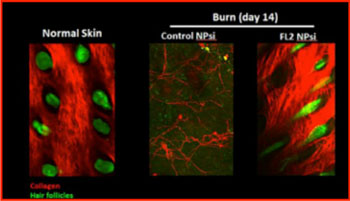Small Interfering RNA Nanoparticles Accelerate Wound Healing in Mouse Model
By LabMedica International staff writers
Posted on 08 Apr 2015
The time required for wound healing in a mouse model was significantly shortened by treatment with nanoparticles that had been loaded with small interfering RNA (siRNA) that blocked the synthesis of the enzyme fidgetin-like 2 (FL2).Posted on 08 Apr 2015
FL2, a fundamental regulator of cell migration, is a microtubule-severing enzyme that belongs to the fidgetin family, which plays varying roles in cellular development and function. When active, FL2 slows the migration of cells involved in the healing process into the wound.

Image: Imaging of burn wounds in mice by confocal microscopy indicates that those treated with FL2 siRNA nanoparticles (far right) experienced collagen deposition and hair follicle formation (Photo courtesy of the Albert Einstein College of Medicine).
Investigators at Albert Einstein College of Medicine (New York, NY, USA) found that depletion of FL2 from mammalian tissue culture cells resulted in a more than two-fold increase in the rate of cell movement, due in part to a significant increase in directional motility. Immunofluorescence analyses indicated that FL2 normally localized to the cell edge, importantly to the leading edge of polarized cells, where it regulated the organization and dynamics of the microtubule cytoskeleton.
To apply these findings to live animals, the investigators facilitated the uptake of FL2-specific siRNA by utilizing a nanoparticle-based delivery platform. The siRNA caused the local depletion of FL2 in mice with both cut and burn wounds by binding to the FL2 gene's messenger RNA (mRNA), which prevented the mRNA from being translated into FL2 proteins.
The investigators reported in the March 10, 2015, online edition of the Journal of Investigative Dermatology that topical application of FL2 siRNA nanoparticles to either wound type resulted in a significant enhancement in the rate and quality of wound closure both clinically and histologically relative to controls. Taken together, these results identified FL2 as a promising therapeutic target to promote the regeneration and repair of cutaneous wounds.
"SiRNAs on their own will not be effectively taken up by cells, particularly inside a living organism" said senior author Dr. David J. Sharp, professor of physiology and biophysics at Albert Einstein College of Medicine. "They will be quickly degraded unless they are put into some kind of delivery vehicle. We saw normal, well-orchestrated regeneration of tissue, including hair follicles and the skin's supportive collagen network. Not only did the cells move into the wounds faster, but they knew what to do when they got there."
"We envision that our nanoparticle therapy could be used to speed the healing of all sorts of wounds, including everyday cuts and burns, surgical incisions, and chronic skin ulcers, which are a particular problem in the elderly and people with diabetes," said Dr. Sharp.
Related Links:
Albert Einstein College of Medicine














